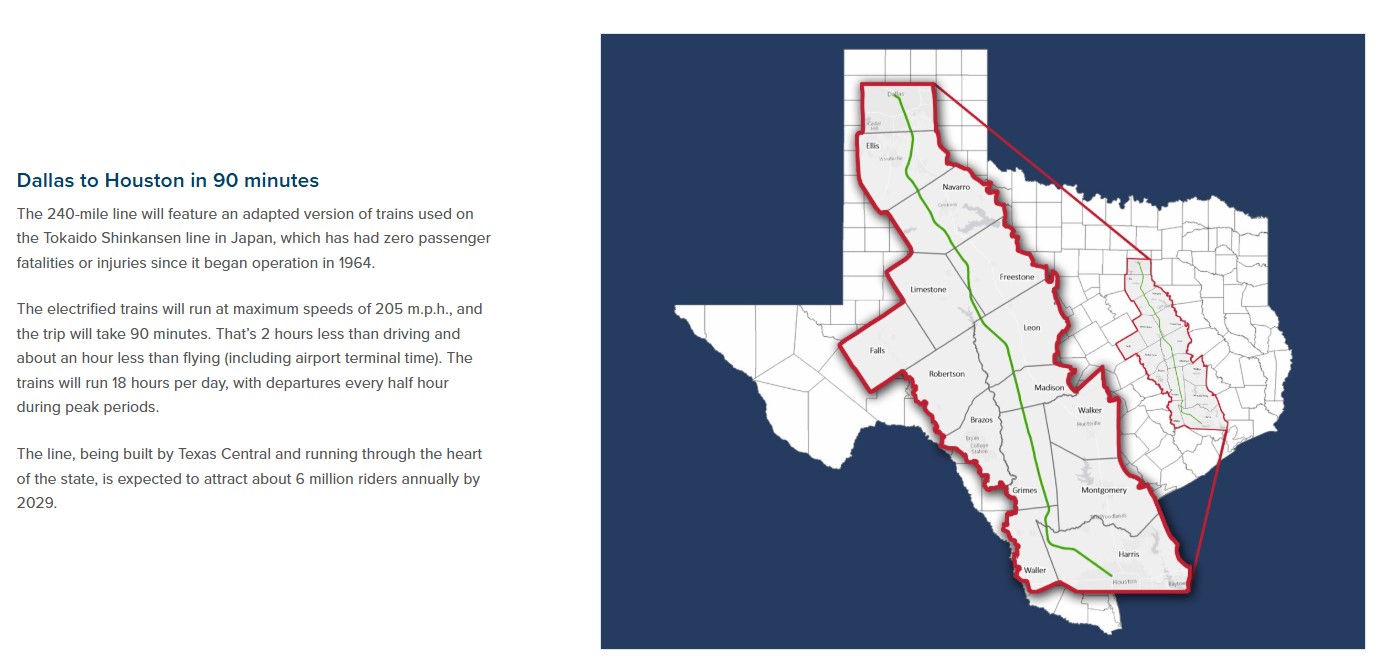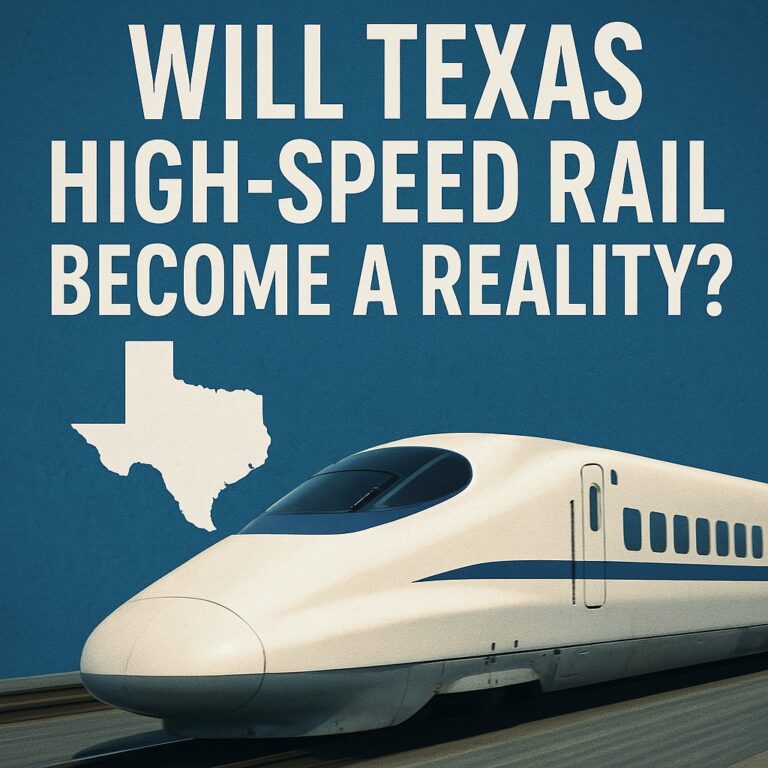The promise of high-speed rail in Texas has been around longer than most TikTok influencers have been alive. Every few years, someone dusts off the same glossy renderings of sleek bullet trains racing between Dallas and Houston. Politicians smile, developers cheer, and press releases pile up faster than the trains themselves ever could. Then everything stalls. Again.
Now Amtrak has stepped in with a fresh coat of federal paint and a $63.9 million grant, hoping to revive what many have called a dead project walking. The vision? A 90-minute ride through flat Texas countryside in a Japanese Shinkansen-style dream machine. The reality? Legal hurdles, landowners lawyering up, and lawmakers doing their best to starve the project of any local funding.
The Texas bullet train feels less like a transportation revolution and more like a recurring fantasy that burns money, drains patience, and refuses to go away. So the real question is not about progress. It is about whether anyone will ever board that train—or if Texans will just keep hearing the whistle blow in PowerPoint slides.
Still Just an Idea With a Website

Texas High-Speed Rail was supposed to be a game-changer. A 90-minute trip between Houston and Dallas. No traffic, no TSA, just clean electric speed rolling through the prairie. That was the fantasy sold to Texans. What they got instead is a ghost project. No ground broken. No rail laid. No clear leadership. Just press releases, lawsuits, and an official website still pretending like everything is on track.
Texas Central, the private firm that once promised to deliver this miracle, collapsed into silence in 2022. The CEO left. No one replaced him. The company’s office is quiet. Updates dried up. Investors backed out. By the time Amtrak stepped in during 2024 with a $63.9 million grant, the idea already looked half-buried. That money cannot build anything. It barely covers planning. It pays for staff, environmental studies, and more consultants—like it has for years.
Meanwhile, Texas lawmakers are pushing to cut the project’s legs off entirely. House Bill 1402 aims to ban state and local funding for any high-speed rail. That includes police, fire, emergency services, even infrastructure support. If it passes, the train will have to operate entirely without any public help from Texas cities or counties. The message is blunt: go federal or go home.
Land is another disaster. Roughly 600 parcels are needed to create the corridor. Only about a quarter of them have been secured. The rest are tangled in lawsuits. Landowners do not want to sell. Eminent domain fights have turned into a slow-motion war in Texas courtrooms.
Here’s where everything stands right now:
| Route | Dallas to Houston (240 miles) |
| Proposed Travel Time | 90 minutes |
| Technology | Japanese N700S Shinkansen |
| Construction Status | Zero construction. No permits, no site work, no physical progress |
| Leadership | CEO resigned 2022. No replacement. Corporate silence since |
| Federal Grant (2024) | $63.9 million via Amtrak, limited to planning |
| Estimated Total Cost | $30 billion+, no confirmed financing plan |
| Land Acquisition | About 25% complete. Rest locked in legal disputes |
| Legislative Threat | HB 1402 may block all state and local support |
The gap between the vision and the ground reality is brutal. Politicians still quote the brochure version. Journalists chase the ghost of momentum. Amtrak sends polite letters to reporters saying they are “committed.” No one has said when actual construction will begin. No one has answered how the rest of the billions will be raised.
Amtrak’s Federal Bailout: Hope or Hype?
🚄 America’s high-speed rail era is here! We operate America’s fastest train (Acela up to 150 mph) and see big potential for HSR beyond the Northeast.
Discover why we believe Dallas ↔️ Houston is a prime candidate for HSR, from Amtrak President Roger Harris and SVP Andy Byford. pic.twitter.com/4zoOe96p8p
— Amtrak (@Amtrak) April 29, 2024
When Amtrak showed up in 2024 with a $63.9 million grant, it looked like a rescue. Headlines lit up. The narrative shifted. Suddenly, the train was not dead—it was back. Except it was not.
That grant came from the Federal-State Partnership for Intercity Passenger Rail Program. It sounds ambitious. But the money does not touch track, trains, or stations. It only funds paperwork. Environmental reviews. Engineering plans. Outreach. The same kinds of documents that have circulated since 2014.
Amtrak officials framed the move as “early-stage development.” They promised to support Texas Central “as a partner.” But that partnership lacks teeth. Amtrak does not hold the land. It does not own the right of way. It does not have construction authority. It cannot override local resistance.
The 90-Minute Promise That Still Lives in Slideshows
Texas Central’s core pitch has never changed: skip the airport, board in Dallas, step off in Houston 90 minutes later. Simple. Efficient. The Japanese Shinkansen tech is proven. Trains run flawlessly in Tokyo and Osaka. But Japan is not Texas.
To replicate that ride here, engineers must deal with flood zones, unstable clay soils, and regulatory hurdles across 10 counties. Every crossing needs redesign. Every floodplain needs mitigation. Every town along the way brings new opposition.
No rolling stock has been ordered. No contractors signed. No construction timeline approved. The “90-minute promise” still lives in slide decks and artist renderings. No one has proven it can survive Texas soil, Texas politics, or Texas courts.
State Lawmakers Are Done Playing Along
Texas lawmakers are tired of the magic show. House Bill 1402 is their answer. If it passes, cities and counties will be banned from spending any public money on high-speed rail. That includes not only direct funding, but indirect support like local law enforcement, emergency responders, even road access work connected to stations.
The bill sends a clear message: build it yourself, or do not build it at all. Private investment has already thinned out. Now, even the chance of local partnerships is in danger.
Lawmakers argue the project has overpromised and underdelivered for too long. Critics say it’s another example of Texas sabotaging its own future. Either way, the effect is chilling.
HB 1402 has strong support. It is not a fringe effort. If passed, the bullet train will face even greater isolation. It may survive federal bureaucracy, but it will not outrun the Texas House.
Landowners Are Not Budging. The Train Is Not Moving.
On a motion by @realmitchlittle, seconded by @JaredLPatterson, the House Transportation Committee just voted to subpoena Texas Central for financial documents and project details related to the Dallas-to-Houston high-speed rail project. #txlege pic.twitter.com/TAGBRmgfV8
— Brad Johnson (@bradj_TX) April 3, 2025
Land acquisition is not a side problem. It is the problem. Without the land, there is no corridor. And Texas Central has secured only about 25 percent of what it needs.
Landowners between Dallas and Houston are not interested in selling. Some are rice farmers. Some run cattle. Others just do not want a bullet train slicing through their property at 200 mph.
More than 90 lawsuits have piled up around land seizure. Texas Central has tried to use eminent domain. Courts keep slowing that down. Judges want proof the project is alive. That proof does not exist yet.
Timeline
| Year | Development |
|---|---|
| 2017 | Texas Central begins land negotiations |
| 2019 | Lawsuits filed across multiple counties |
| 2021 | Court temporarily backs eminent domain |
| 2022 | CEO resigns. Project stalls. Lawsuits freeze |
| 2024 | Amtrak joins. No land movement since |
The Tech Sounds Slick—Until It Hits Texas Soil
Japan’s N700S Shinkansen system is the pride of high-speed rail. Quiet. Fast. Shockingly reliable. It cuts through Japan like clockwork. But in Texas, it’s not plug-and-play.
Here’s What Needs Changing
- Soil: Texas has black gumbo clay that swells and cracks. Japan doesn’t.
- Flooding: The route passes through flood-prone counties. Japan’s bullet trains don’t.
- Power Supply: Shinkansen trains run on a dedicated power grid. Texas will need to build one from scratch.
- Standards: Every rail segment must pass federal inspection. The system must also adjust to U.S. safety codes.
Engineers would need to tweak almost every part of the original design. That adds time. That adds cost. That adds risk.
No Price Tag. No Clarity. No Trust.
The project’s estimated cost keeps floating above $30 billion. But no one will confirm the actual number. Texas Central stopped providing financial updates years ago. Amtrak won’t say either.
- Federal support: $63.9 million (for planning only)
- Private investors: Unnamed, quiet, possibly gone
- Local funds: On the verge of being banned
- Loan prospects: Undefined, unannounced, uncertain
The silence around the numbers is the loudest part of the story. Nobody wants to be tied to a project that cannot promise cost control. And Texans are not known for forgiving boondoggles.
No One Is in Control
There is no single person or agency currently directing Texas High-Speed Rail. Texas Central lost its CEO in 2022. The company has not introduced a replacement. Amtrak has stepped in—but only on paper.
The $63.9 million federal grant in 2024 helped the headlines. But not the actual structure. No executive leadership, no updated cost analysis, and no working governance model have been shown to the public.
What is Missing
- Chief executive or board in public view
- New cost estimate since early projections
- Construction partner officially named
- Signed agreement with federal regulators
Final Thoughts
Here’s the reality. You can only stretch a promise so far before it snaps. That’s exactly where the Texas bullet train stands now—tangled in its own hype, gasping for relevance.
The idea still makes sense. Connecting two of the country’s fastest-growing cities with one of the world’s fastest trains? Logical. Needed. Obvious. But a good idea means nothing if no one’s in charge, no one’s building, and no one’s paying the bill.
Right now, there’s no evidence this thing is heading anywhere. The company behind it drifted into silence. The federal government tossed it a lifeline without taking the wheel. State lawmakers are already writing its obituary. And most Texans are done waiting.
People wanted a train. What they got was a website, a grant, and a very expensive question mark.
So the answer is simple:
Until someone shows up with authority, money, and a bulldozer—it’s not real.
So if this bullet train saga is giving you a headache, take comfort—Texas still runs on time when it comes to deep-fried butter, oversized turkey legs, and the State Fair. No permits. No lawsuits. Just corndogs and a working schedule.

